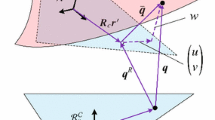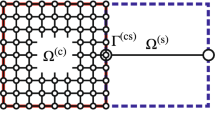Abstract
In a multibody system consisting of shell structures, the contact may appear in any area of shells. It is difficult to simulate the contact of shells with large deformation because of the geometric nonlinearity of deformation and the boundary nonlinearity of contact. This study presents a rotation-free shell formulation and an extended contact discretization in multibody systems using a corotational frame. This model is different from previous formulations in the definition of the local frame and the processing of local large curvature. In order to deal with the shell contact, a unified contact discretization scheme including edge-to-edge contact for facet triangle shell elements is proposed to solve the large penetration problem. A series of numerical examples of multibody dynamics have validated the approach of the nonlinear shell model and contact treatments. Moreover, a practical application of deployment of solar cells shows the capability of the proposed formulation in solving large-scale problems of flexible multibody system with large deformation and contact.





































Similar content being viewed by others
References
ABAQUS: ABAQUS Theory Guide. Dassault Systèmes, Providence, RI, USA (2017)
ABAQUS: ABAQUS Users’s Guide Volume V: Prescribed Conditions, Constraint & Interactions. Dassault Systèmes, Providence, RI, USA (2017)
Areias, P., Garção, J., Pires, E.B., Barbosa, J.I.: Exact corotational shell for finite strains and fracture. Comput. Mech. 48, 385–406 (2011)
Arnold, M., Brüls, O.: Convergence of the generalized-\(\alpha \) scheme for constrained mechanical systems. Multibody Syst. Dyn. 18(2), 185–202 (2007)
Bauchau, O., Choi, J.Y., Bottasso, C.L.: On the modeling of shells in multibody dynamics. Multibody Syst. Dyn. 8, 459–489 (2002)
Crisfield, M.A.: A unified co-rotational framework solids, shells and beams. Int. J. Solids Struct. 33(1986), 2969–2992 (1996)
Das, M., Barut, A., Madenci, E.: Analysis of multibody systems experiencing large elastic deformations. Multibody Syst. Dyn. 23(1), 1–31 (2009)
Eberhard, P., Hu, B.: Advanced Contact Dynamics. Southeast University Press, Nanjing (2003)
Felippa, C.A., Haugen, B.: A unified formulation of small-strain corotational finite elements: I. Theory. In: Computer Methods in Applied Mechanics and Engineering (2005)
Flores, F.G., Oñate, E.: Improvements in the membrane behaviour of the three node rotation-free BST shell triangle using an assumed strain approach. Comput. Methods Appl. Mech. Eng. 194(6–8), 907–932 (2005)
Flores, F.G., Oñate, E.: Wrinkling and folding analysis of elastic membranes using an enhanced rotation-free thin shell triangular element. Finite Elem. Anal. Des. 47(9), 982–990 (2011)
Gärdsback, M., Tibert, G.: A comparison of rotation-free triangular shell elements for unstructured meshes. Comput. Methods Appl. Mech. Eng. 196(49–52), 5001–5015 (2007)
Guo, Y.Q., Gati, W., Naceur, H., Batoz, J.L.: An efficient DKT rotation free shell element for springback simulation in sheet metal forming. Comput. Struct. 80, 2299–2312 (2002)
Hallquist, J.O.: LS-DYNA Theory manual. March (2006)
Hallquist, J.O., Goudreau, G.L., Benson, D.J.: Sliding interfaces with contact-impact in large-scale Lagrangian computations. Comput. Methods Appl. Mech. Eng. 51(1–3), 107–137 (1985)
Klaus-Jurgen, B., Chaudhary, A.: A solution method for planar and axisymmetric contact problems. Int. J. Numer. Methods Eng. 21, 65–88 (1985)
Konyukhov, A., Izi, R.: Introduction to Computational Contact Mechanics. Wiley, Chichester (2015)
Linhard, J., Wüchner, R., Bletzinger, K.U.: “Upgrading” membranes to shells—the CEG rotation free shell element and its application in structural analysis. Finite Elem. Anal. Des. 44(1–2), 63–74 (2007)
Liu, Z., Hong, J., Liu, J.: Finite element formulation for dynamics of planar flexible multi-beam system. Multibody Syst. Dyn. 22(1), 1–26 (2009)
Liu, Z., Liu, J.: Experimental validation of rigid-flexible coupling dynamic formulation for hub–beam system. Multibody Syst. Dyn. 40(3), 303–326 (2017)
LS-DYNA: LS-DYNA keyword user’s manual volume I. Livermore Software Technology Corporation, Livermore, California (2017)
Lu, J., Zheng, C.: Dynamic cloth simulation by isogeometric analysis. Comput. Methods Appl. Mech. Eng. 268, 475–493 (2014)
Mcdevitt, T.W., Laursen, T.A.: A mortar-finite element formulation for frictional contact problems. Int. J. Numer. Methods Eng. 48(10), 1525–1547 (2000)
Mikkola, A.K.I.M., Shabana, A.A.: A non-incremental finite element procedure for the analysis of large deformation of plates and shells in mechanical system applications. Multibody Syst. Dyn. 9, 283–309 (2003)
Moller, T.: Fast triangle-triangle intersection test. Doktorsavh. Chalmers Tek. Högsk. 1425, 123–129 (1998)
Nour-Omid, B., Rankin, C.: Finite rotation analysis and consistent linearization using projectors. Comput. Methods Appl. Mech. Eng. 93(3), 353–384 (1991)
Oñate, E., Cendoya, P., Miquel, J.: Non-linear explicit dynamic analysis of shells using the BST rotation-free triangle. Eng. Comput. 19(6), 662–706 (2002)
Oñate, E., Cervera, M.: Derivation of thin plate bending elements with one degree of freedom per node: a simple three node triangle. Eng. Comput. 10(6), 543–561 (1993)
Oñate, E., Flores, F.G.: Advances in the formulation of the rotation-free basic shell triangle. Comput. Methods Appl. Mech. Eng. 194(21–24), 2406–2443 (2005)
Phaal, R., Calladine, C.R.: A simple class of finite elements for plate and shell problems. I: Elements for beams and thin flat plates. Int. J. Numer. Methods Eng. 35(5), 955–977 (1992)
Phaal, R., Calladine, C.R.: Simple class of finite elements for plate and shell problems. II: An element for thin shells, with only translational degrees of freedom. Int. J. Numer. Methods Eng. 35(5), 979–996 (1992)
Puso, M.A., Laursen, T.A.: A mortar segment-to-segment contact method for large deformation solid mechanics. Comput. Methods Appl. Mech. Eng. 193(6–8), 601–629 (2004)
Sabourin, F., Brunet, M.: Analysis of plates and shells with a simplified three node triangular element. Thin-Walled Struct. 21(3), 209–223 (1995)
Sabourin, F., Brunet, M.: Detailed formulation of the rotation-free triangular element “S3” for general purpose shell analysis. Eng. Comput. 23(5), 469–502 (2006)
Schiehlen, W., Guse, N., Seifried, R.: Multibody dynamics in computational mechanics and engineering applications. Comput. Methods Appl. Mech. Eng. 195(41–43), 5509–5522 (2006)
Schiehlen, W., Seifried, R.: Three approaches for elastodynamic contact in multibody systems. Multibody Syst. Dyn. 12(1), 1–16 (2004)
Shabana, A., Christensen, A.: Three dimensional absolute nodal coordinate formulation: plate problem. Int. J. Numer. Methods Eng. 40, 2775–2790 (1997).
Simo, J.: On a stress resultant geometrically exact shell model. Part VII: Shell intersections with 5/6-DOF finite element formulations. Comput. Methods Appl. Mech. Eng. 108(3–4), 319–339 (1993)
Sze, K.Y., Zhou, Y.X.: An efficient rotation-free triangle for drape/cloth simulations—part I: model improvement, dynamic simulation and adaptive remeshing. Int. J. Comput. Methods 13(3), 1650021 (2016)
Temizer, I., Wriggers, P., Hughes, T.: Three-dimensional mortar-based frictional contact treatment in isogeometric analysis with NURBS. Comput. Methods Appl. Mech. Eng. 209–212, 115–128 (2012)
Wriggers, P.: Computational Contact Mechanics. Springer, Berlin (2006)
Wriggws, P., Stbin, E.: Finite element formulation deformation impact-contact with friction of large problems. Comput. Struct. 37(3), 319–331 (1990)
Zhou, Y., Sze, K.: A geometric nonlinear rotation-free triangle and its application to drape simulation. Int. J. Numer. Methods Eng. 89, 509–536 (2011)
Zhou, Y.X., Sze, K.: An Efficient Rotation-Free Triangle and its Application in Cloth Simulations. Ph.D. thesis, The University of Hong Kong (2013)
Acknowledgements
This research was supported by the National Natural Science Foundation of China (No. 11772188, No. 11132007), for which the authors are grateful.
Author information
Authors and Affiliations
Corresponding author
Additional information
Publisher’s Note
Springer Nature remains neutral with regard to jurisdictional claims in published maps and institutional affiliations.
Rights and permissions
About this article
Cite this article
Shi, J., Liu, Z. & Hong, J. Dynamic contact model of shell for multibody system applications. Multibody Syst Dyn 44, 335–366 (2018). https://doi.org/10.1007/s11044-018-09641-5
Received:
Accepted:
Published:
Issue Date:
DOI: https://doi.org/10.1007/s11044-018-09641-5




